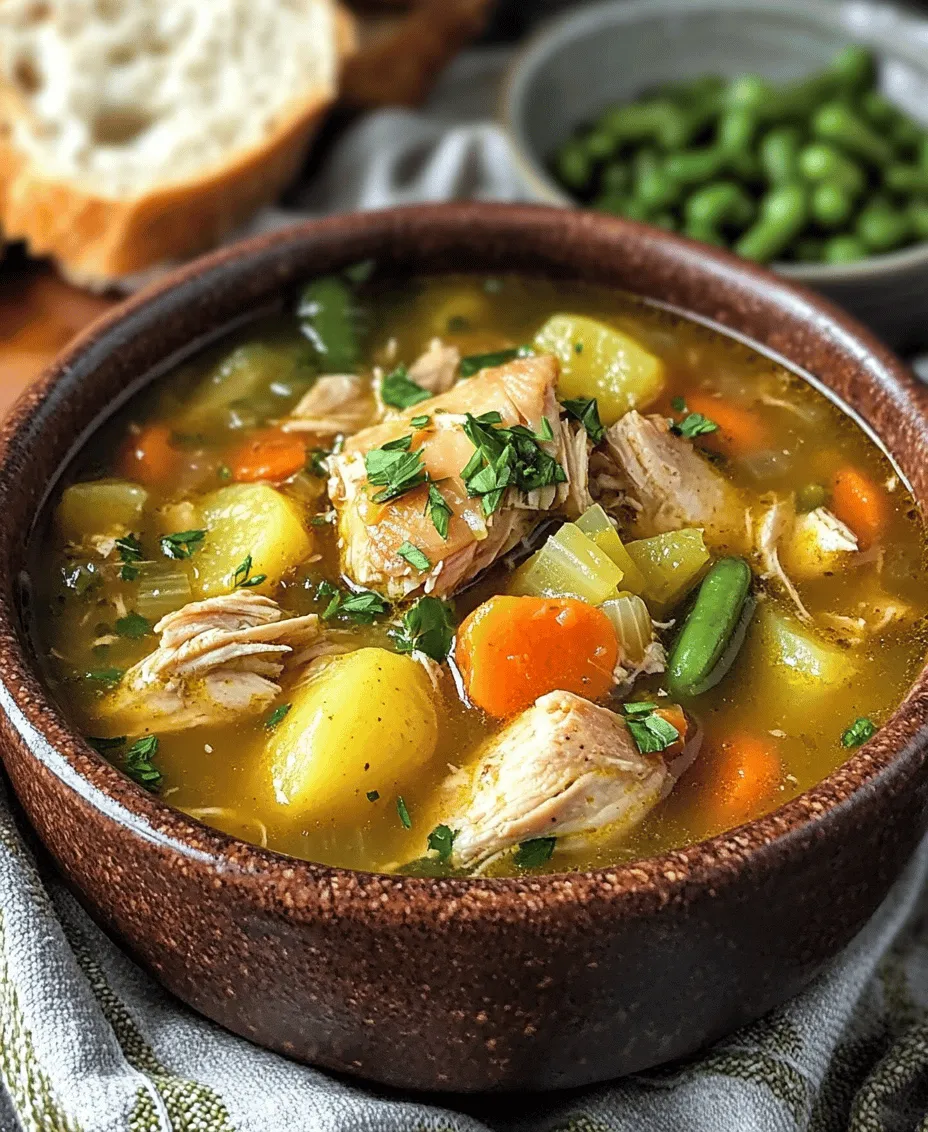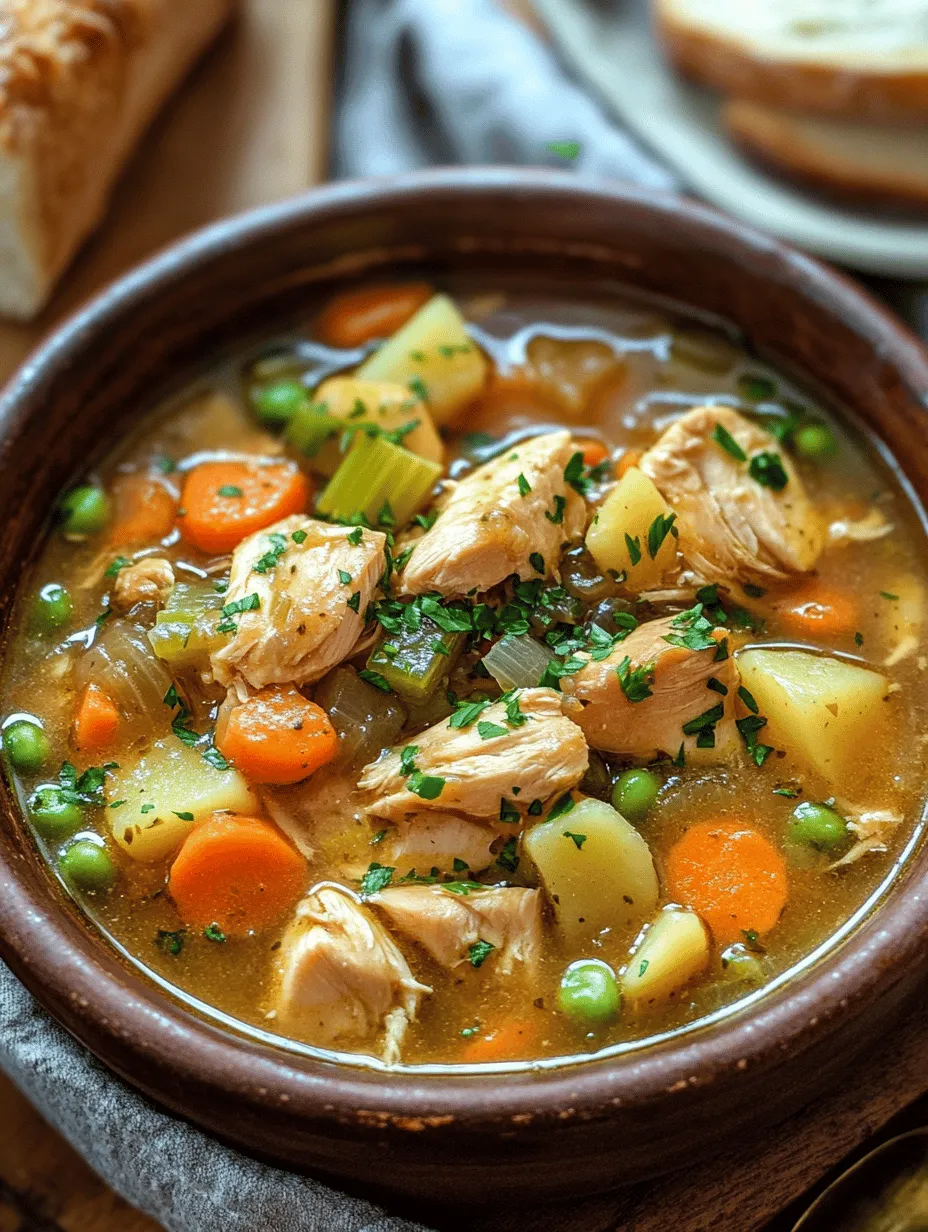Introduction
Discover the comfort of home-cooked meals with this Slow Cooker Chicken Stew recipe. This hearty dish combines tender chicken, fresh vegetables, and a rich broth, making it the perfect meal for any occasion. Whether you’re looking to warm up after a long day or simply enjoy a nutritious dinner with family, this stew is sure to satisfy. In this article, we will delve into the details of this recipe, including its ingredients, preparation steps, and the delightful flavors that come together in the slow cooker.
The allure of slow cooker meals is undeniable. They offer a simple, yet effective way to create hearty dishes without spending hours in the kitchen. In the following sections, we’ll uncover the benefits of slow cooking, explore why chicken stew is a classic comfort food, and provide a detailed breakdown of essential ingredients needed for this delightful stew.
The Allure of Slow Cooker Meals
Understanding Slow Cooking
The Benefits of Slow Cooking for Flavor and Tenderness
Slow cooking is a culinary technique that allows food to simmer at low temperatures over an extended period. This method is particularly beneficial for tough cuts of meat, such as chicken thighs, which become incredibly tender as they absorb the surrounding flavors. The slow simmering process breaks down the connective tissues in the meat, resulting in a melt-in-your-mouth texture that is hard to achieve with traditional cooking methods.
Additionally, the low and slow heat allows for the gradual melding of flavors. When you toss fresh herbs and spices into the slow cooker, their essential oils are released slowly, infusing the dish with a depth of flavor that is truly remarkable. The result is a stew that is not only delicious but also richly aromatic.
How Slow Cooking Enhances Nutritional Value
One of the often-overlooked benefits of slow cooking is its ability to preserve the nutritional value of ingredients. The extended cooking time at lower temperatures retains vitamins and minerals that might otherwise be lost in quicker cooking methods. Moreover, the slow cooking process allows for the use of whole, unprocessed ingredients, making it easier to create healthier meals that are packed with nutrients.
For those mindful of their dietary choices, slow cooking enables you to incorporate a variety of vegetables, lean proteins, and wholesome grains into your meals. This not only boosts the nutritional content but also promotes a balanced diet.
Why Chicken Stew is a Comfort Food
Historical Context of Chicken Stew as a Comfort Food
Chicken stew is a dish that has stood the test of time, cherished across various cultures and generations. Its origins can be traced back to traditional cooking practices, where families would gather around a pot of simmering stew, sharing stories and enjoying the warmth of each other’s company. The simplicity of its ingredients—often just chicken, vegetables, and broth—made it a staple in many households.
Throughout history, chicken stew has been associated with nourishment and comfort, particularly during colder months or times of illness. Its ability to warm both the body and soul has solidified its status as a go-to comfort food. In many cultures, variations of chicken stew have become family recipes passed down through generations, each with its own unique twist.
The Significance of Hearty Meals in Various Cultures
Across different cultures, hearty meals like chicken stew hold significant meaning. They serve as a source of comfort and are often prepared for family gatherings, celebrations, or simply to bring people together. In many households, the ritual of crafting a warm stew becomes a cherished tradition, creating lasting memories around the dinner table.
For instance, in Ireland, chicken and vegetable stew is a staple that embodies the principles of simplicity and home cooking. In Southern United States cuisine, chicken and dumplings are a beloved comfort dish that evokes feelings of nostalgia. The universal appeal of chicken stew lies in its ability to adapt to regional ingredients and flavors, all while maintaining its essence as a nourishing meal designed to comfort and satisfy.
Ingredients Breakdown
Essential Ingredients for Chicken Stew
Overview of Core Ingredients: Chicken, Vegetables, Broth
The foundation of any great chicken stew lies in its core ingredients. For this slow cooker version, you will need:
– Chicken Thighs: These cuts are preferred for their rich flavor and tenderness, especially after slow cooking. They hold up well and won’t dry out during the long cooking process.
– Fresh Vegetables: A medley of vegetables such as carrots, celery, and potatoes adds not only flavor but also texture and nutrition to the stew. Each vegetable contributes its unique taste, creating a harmonious blend.
– Broth: A good quality broth or stock is essential for building the base of the stew. It should be flavorful and provide the necessary moisture for cooking the ingredients to perfection.
The Role of Each Ingredient in Enhancing Flavor
Each ingredient in chicken stew plays a vital role in creating a balanced and flavorful dish. The chicken thighs provide a savory depth, while the vegetables contribute sweetness and earthiness. The broth acts as the glue that ties everything together, enriching the overall flavor profile.
Herbs and spices, such as thyme, bay leaves, and pepper, can also be added to the mix, elevating the flavor complexity. These ingredients not only enhance the taste but also offer aromatic qualities that make the stew inviting and comforting.
Quality Matters: Choosing the Right Ingredients
Selecting the Best Chicken Thighs for Tenderness
When it comes to chicken, quality is paramount. Opt for bone-in, skin-on chicken thighs for the best flavor and moisture retention. The skin adds richness, while the bones contribute to a more robust broth. If you’re concerned about excess fat, you can always remove the skin after cooking.
Look for chicken that is free-range or organic, as these options often result in better flavor and texture. Freshness is key, so try to purchase chicken from a reputable source, ensuring that it’s stored properly and free from any off-putting odors.
Choosing Fresh Vegetables for Optimal Taste
Fresh vegetables are the heart and soul of any good stew. When selecting vegetables, choose those that are in season and sourced locally when possible. This not only supports your local farmers but also guarantees that you’re using the freshest produce available.
Carrots should be firm and brightly colored, while celery should be crisp with minimal blemishing. Potatoes should be free of sprouts and soft spots. Using a combination of root vegetables and greens can add depth to the stew’s flavor and texture, making every spoonful a delightful experience.
The Importance of Low-Sodium Broth for Health-Conscious Cooking
For those watching their sodium intake, choosing a low-sodium broth is a wise decision. Homemade broth is an excellent option, allowing you to control the ingredients and seasoning levels. If store-bought broth is your preference, ensure it’s labeled as low-sodium to create a healthier stew without sacrificing flavor.
By using low-sodium broth, you can always adjust the seasoning to your liking later in the cooking process, ensuring that your stew remains both delicious and nutritious.
Step-by-Step Preparation Guide
Preparing the Chicken: The Searing Process
Importance of Searing for Flavor Development
Searing the chicken before adding it to the slow cooker is a crucial step that enhances the overall flavor of the stew. This technique involves cooking the meat at high heat to create a golden-brown crust, which develops rich, complex flavors through the Maillard reaction. Searing locks in moisture and adds depth to the stew, elevating the dish from ordinary to extraordinary.
Step-by-Step Instructions on How to Sear Chicken Thighs
1. Heat the Oil: In a large skillet, heat a tablespoon of olive oil over medium-high heat. The oil should shimmer but not smoke.
2. Season the Chicken: While the oil is heating, season the chicken thighs generously with salt and pepper. This basic seasoning is essential for building flavor.
3. Sear the Chicken: Carefully place the chicken thighs in the hot skillet, skin side down. Avoid overcrowding the pan; you may need to work in batches. Sear for about 5-7 minutes until the skin is golden brown and crispy.
4. Flip and Sear the Other Side: Using tongs, flip the chicken and sear the opposite side for an additional 3-5 minutes. Once browned, transfer the chicken to a plate and set aside.
5. Deglaze the Pan: To capture all the flavorful bits left in the skillet, add a splash of broth or water to the hot pan, scraping the bottom with a wooden spoon. This mixture can be added to the slow cooker for extra flavor.
Sautéing the Aromatics
The Significance of Onions and Garlic in Flavor Base
No stew is complete without a solid flavor foundation, and that begins with aromatics like onions and garlic. These ingredients form the base of the stew, imparting sweetness and depth that enhances the overall dish.
Sautéing the onions until they are translucent and fragrant will release their natural sugars, contributing to a rich and savory flavor. Garlic, added later in the process, provides a punch of flavor that brightens the dish.
As we move forward in this recipe, the sautéing process will be one of the essential steps in developing the hearty, comforting flavors that make this Slow Cooker Chicken Stew a beloved meal.
By understanding the importance of each ingredient and preparation step, you’re setting the stage for a delicious and satisfying dish that will warm your home and heart. Stay tuned as we continue to explore the remaining steps for creating this comforting stew.

Tips for Achieving the Perfect Sauté
Before diving into the slow cooker process, it’s essential to master the art of sautéing your vegetables and chicken. Sautéing is not just about cooking; it’s about developing flavors that will elevate your chicken stew to the next level. Here are some tips for achieving the perfect sauté:
1. Use the Right Pan: A heavy-bottomed skillet or Dutch oven is ideal for sautéing as it distributes heat evenly, preventing burning.
2. Preheat Your Pan: Allow your pan to heat up before adding oil. This helps to sear the chicken and vegetables, creating a flavorful crust.
3. Don’t Overcrowd the Pan: If you add too many ingredients at once, they will steam rather than sauté. Work in batches if necessary.
4. Choose Your Oil Wisely: Use oils with high smoke points like canola or avocado oil for sautéing. Olive oil can also be used but avoid heating it to its smoke point.
5. Season Wisely: Add salt and pepper to your chicken and vegetables while sautéing to enhance their natural flavors. Consider adding herbs like thyme or rosemary for extra depth.
Layering the Stew: Vegetables and Broth
Layering ingredients properly in your slow cooker is crucial for achieving the best results. The order in which you add your ingredients can impact the final flavor and texture of the stew.
How to Layer Ingredients in a Slow Cooker for Best Results
1. Start with Vegetables: Place heartier vegetables like carrots, potatoes, and onions at the bottom of the slow cooker. These vegetables take longer to cook and benefit from the direct heat of the cooker.
2. Add the Protein: After the vegetables, layer in your chicken. This will allow the meat’s juices to mingle with the vegetables, enriching the overall flavor.
3. Include Seasonings and Herbs: Sprinkle your herbs and spices over the chicken and vegetables. This helps to infuse the flavors throughout the stew.
4. Pour in the Broth: Finally, pour in your broth or stock. Ensure it covers the ingredients to keep everything moist during cooking.
Preparing the Broth Mixture: Balancing Flavors
The broth is the soul of your chicken stew. To create a well-balanced flavor, consider the following:
– Use Quality Broth: Homemade chicken broth is ideal, but store-bought can work too. Look for low-sodium options to control salt levels.
– Enhance with Aromatics: Add garlic, bay leaves, and peppercorns to the broth for added depth.
– Acidity Matters: A splash of vinegar or lemon juice can brighten the flavors of the stew, balancing richness with acidity. Add this just before serving to maintain freshness.
Cooking Techniques: Low and Slow vs. High Heat
Understanding the cooking techniques of slow cooking can greatly impact the outcome of your chicken stew.
Detailed Comparison of Cooking Times and Outcomes
– Low Setting (8-10 Hours): Cooking on low heat allows flavors to meld beautifully over a longer period. The chicken becomes tender, and the vegetables maintain their shape while soaking up the broth’s flavors.
– High Setting (4-6 Hours): Cooking on high heat is suitable if you’re short on time. While it still produces a delicious stew, the flavors may not be as deeply developed as with the low setting. The chicken will also be tender, but there’s a higher risk of overcooking the vegetables.
Understanding the Science Behind Slow Cooking
Slow cooking is a gentle process that allows flavors to develop gradually. The low temperature encourages the breakdown of collagen in the chicken, resulting in a tender, juicy dish. Furthermore, the long cooking time allows for the release of flavors from the ingredients, creating a rich and hearty stew that is comforting and satisfying.
Cooking Duration and Serving Suggestions
Breakdown of Cooking Time Based on Settings
– Low: 8-10 hours
– High: 4-6 hours
Adjust these times based on your slow cooker model, as some may cook faster than others. Always refer to your user manual for specific guidance.
Signs That Your Chicken Stew is Perfectly Cooked
– Tender Chicken: The chicken should shred easily with a fork.
– Soft Vegetables: The vegetables should be tender but not mushy.
– Rich Broth: The broth should be flavorful and aromatic, with a balanced taste.
Serving Your Chicken Stew
Ideas for Garnishing: The Role of Fresh Parsley
Garnishing your chicken stew not only enhances its visual appeal but also adds fresh flavor. Chopped fresh parsley is a perfect garnish. Its bright green color and fresh taste provide a lovely contrast to the rich, hearty stew. You can also consider garnishing with a sprinkle of black pepper or a drizzle of olive oil for added richness.
Suggested Accompaniments: Crusty Bread or Rice
When it comes to serving your chicken stew, consider pairing it with:
– Crusty Bread: Freshly baked bread is perfect for soaking up the flavorful broth. A warm baguette or a rustic country loaf works wonderfully.
– Rice: A side of fluffy white rice or brown rice can complement the stew and provide a filling meal.
Nutritional Analysis of the Chicken Stew
Caloric Breakdown
A serving of slow cooker chicken stew typically contains around 300-400 calories, depending on the ingredients used. The caloric content may vary based on the amount of chicken, vegetables, and broth.
Nutritional Benefits of Key Ingredients
– Chicken: A great source of protein, essential for muscle repair and overall body function.
– Vegetables: Carrots, potatoes, and onions provide vitamins, minerals, and dietary fiber, promoting digestive health.
– Herbs and Spices: Fresh ingredients like garlic and parsley offer antioxidants and anti-inflammatory benefits.
Health Benefits of Homemade Stews
Homemade meals like chicken stew come with numerous health advantages:
– Control Over Ingredients: You can choose high-quality, fresh ingredients without preservatives or artificial additives.
– Incorporating Vegetables: Homemade stews are an excellent way to sneak in a variety of vegetables, ensuring you meet your daily nutrient needs.
– Comfort and Satisfaction: Eating a warm bowl of chicken stew can be emotionally satisfying, offering comfort and a sense of well-being.
Conclusion
In conclusion, this Slow Cooker Chicken Stew is not just a meal; it’s an experience that brings warmth and comfort to your table. With its rich flavors and wholesome ingredients, this dish stands out as a nourishing option for families and individuals alike. By following the steps outlined in this article, you can create a delightful stew that embodies the essence of comfort food, making it a staple in your home-cooked repertoire. Enjoy the process, savor the flavors, and indulge in the joy of sharing this hearty meal with loved ones. Whether you choose to serve it with crusty bread or a side of rice, this chicken stew will undoubtedly become a cherished recipe in your culinary collection.

